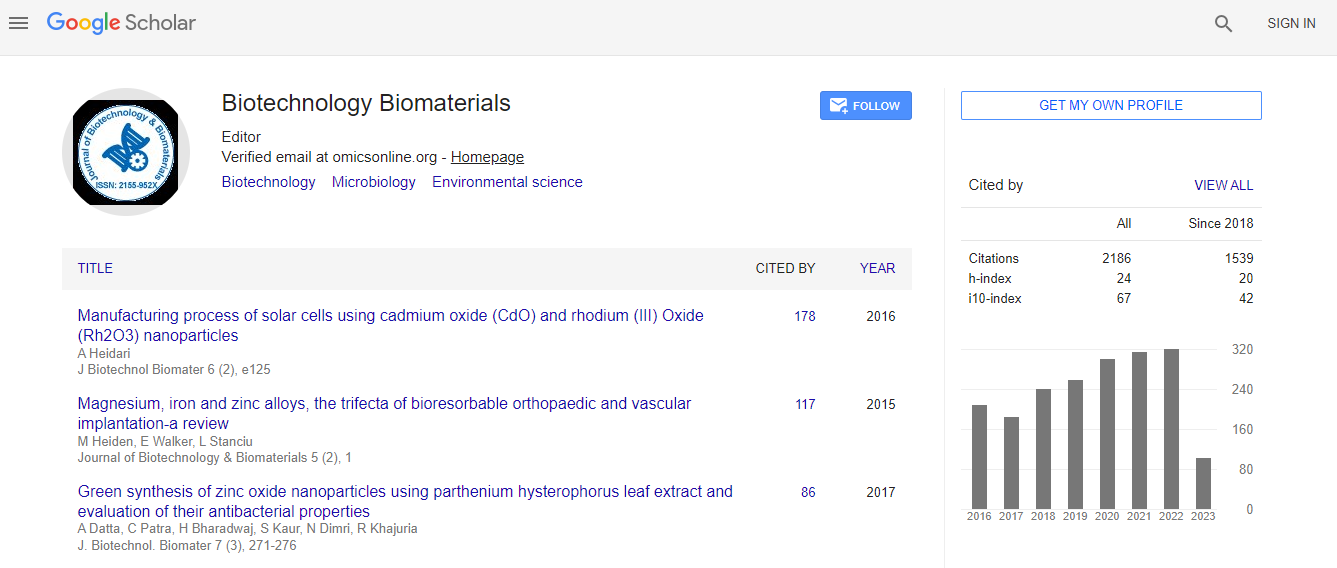Our Group organises 3000+ Global Conferenceseries Events every year across USA, Europe & Asia with support from 1000 more scientific Societies and Publishes 700+ Open Access Journals which contains over 50000 eminent personalities, reputed scientists as editorial board members.
Open Access Journals gaining more Readers and Citations
700 Journals and 15,000,000 Readers Each Journal is getting 25,000+ Readers
Google Scholar citation report
Citations : 3330
Journal of Biotechnology & Biomaterials received 3330 citations as per Google Scholar report
Indexed In
- Index Copernicus
- Google Scholar
- Sherpa Romeo
- Open J Gate
- Genamics JournalSeek
- Academic Keys
- ResearchBible
- China National Knowledge Infrastructure (CNKI)
- Access to Global Online Research in Agriculture (AGORA)
- Electronic Journals Library
- RefSeek
- Hamdard University
- EBSCO A-Z
- OCLC- WorldCat
- SWB online catalog
- Virtual Library of Biology (vifabio)
- Publons
- Geneva Foundation for Medical Education and Research
- Euro Pub
- ICMJE
Useful Links
Recommended Journals
Related Subjects
Share This Page
Accumulation of carotenoids and expression of carotenoid biosynthetic genes during maturation in rice grains (Oryza sativa L.)
6th World Congress on Biotechnology
Upasna Chettry and N K Chrungoo
North Eastern Hill University, India
ScientificTracks Abstracts: J Biotechnol Biomater
Abstract
Cereal grains are important and rich sources of phytochemicals that have significant effects on human health. With the growing interest in the use of valuable dietary phytochemicals, rice bran has been intensively studied for its biologically active components. Our study investigated the relationship between carotenoid accumulation and expression of carotenoid biosynthetic gene during the developmental stages of seed maturation in rice cultivars varying in their bran color. Transcription levels of the key regulatory genes viz., psy pds lcy and �� ch were higher in rice grain containing colored bran indicating that carotogenesis is an ongoing process in mature bran. The highest level of expression and subsequent carotenoid accumulation was noted in the purple cultivar having 44.30 �¼g/gm of beta carotene, 25.07 �¼g/gm of zeaxanthine and 2.304 �¼g/gm of lutein. With the transition from the milking to the mature stage of grain filling in the purple cultivar, the change from ��, â�¬ carotenoid (�±-car and lutein) accumulation to ��, �� carotenoid (��-car, zea, etc) accumulation was observed. On the other hand the brown cultivars showed no detectable level of beta carotene, although 3.14 �¼g/gm of zeaxanthine and 6.72 �¼g/gm of lutein were noted. To further analyze the transcription patterns of carotenoid synthesis and metabolism, the bran layer from the purple and brown cultivars were removed. Noticeably, the purple variety showed reduced gene expression with the accumulation 0.1 �¼g/gm of �� carotene on the other hand, the brown cultivars showed non-detectable level of expression and carotenoid accumulation. Transcriptome profile generated by Ion torrent further gave a better insight into the underlying mechanism that affects enzyme synthesis/activity causing variation in the expression pattern and carotenoid content in the different developmental across the varieties. Thus, our study indicates the potential use of purple rice as a genetic source in rice breeding programs aimed to develop new varieties of rice that have a high content of provitamin A.Biography
Upasna Chettry is a Junior Research Fellow availing INSPIRE Fellowship in the Department of Botany, North Eastern Hill University, Shillong. She has participated in many national conferences and symposium. She has been awarded Best presentation by PLOS at NGBT Conferences, 2014.
Email: upasna.chettri485@gmail.com

 Spanish
Spanish  Chinese
Chinese  Russian
Russian  German
German  French
French  Japanese
Japanese  Portuguese
Portuguese  Hindi
Hindi 
